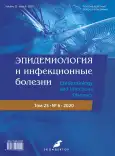The use of computer techniques to optimize the diagnosis of tuberculosis in HIV-infected patients at the secondary diseases stage
- Authors: Umbetova K.T.1, Arutyunova D.D.1, Gerasimov A.N.1, Belaya O.F.1, Malov V.A.1, Pshenichnaya N.Y.2
-
Affiliations:
- The First Sechenov Moscow State Medical University
- Central Research Institute of Epidemiology
- Issue: Vol 25, No 6 (2020)
- Pages: 236-245
- Section: Original study articles
- URL: https://journals.rcsi.science/1560-9529/article/view/82731
- DOI: https://doi.org/10.17816/EID82731
- ID: 82731
Cite item
Full Text
Abstract
ВACKGROUND: The course of tuberculosis in HIV-infected patients has no significant clinical and diagnostic differences from damage to organs and systems of other etiology. The growth of new cases of HIV/TB co-infection necessitates a revision of diagnostic approaches, their improvement in order to increase the efficiency of examination and management of HIV-infected patients, depending on the stage and indicators of the immune status.
AIM: Of the study was to determine by the method of complex statistical processing the main clinical and laboratory-instrumental criteria for improving the diagnosis of tuberculosis in HIV-infected patients at the stage of secondary diseases.
MATERIALS AND METHODS: The study design was retrospective. The object of the research was the case histories of 113 patients with HIV infection at the stage of secondary diseases (classification by V.I. Pokrovsky), of parametric and nonparametric statistics, computer analysis of images with the gradient program proposed by Dr. Sci. A.N. Gerasimov, to assess the possibility of using micro- and macro-preparations of tissues and organs of patients with HIV infection.
RESULTS: Using the method of correlation adaptometry, it was found that there are no significant differences in the clinical course of HIV-infected patients with tuberculosis of various localization, and with lesions of the respiratory organs of other etiology. The use of multivariate probability models made it possible to identify significant diagnostic risk factors for lethal outcome ― 66.7% of patients with further lethal outcome complained of chest pain during breathing (p=0.004), and ESR was significantly accelerated in patients with a lethal outcome in the hospital ― 77±1.99 (p=0.019).
CONCLUSION: The multicomplex instrumental and laboratory examination makes it possible to diagnose tuberculosis of various localization at the initial stage of development. The use of computer techniques optimizes and unifies the diagnostic search in patients with HIV infection and determines the timely treatment tactics.
Full Text
##article.viewOnOriginalSite##About the authors
Karina T. Umbetova
The First Sechenov Moscow State Medical University
Email: karinasara@inbox.ru
ORCID iD: 0000-0003-0902-9267
SPIN-code: 3197-9205
MD, Dr. Sci. (Med.)
Russian Federation, 8-2 Trubetskaya street, 119991 MoscowDaria D. Arutyunova
The First Sechenov Moscow State Medical University
Email: dashulka_555@mail.ru
ORCID iD: 0000-0003-0058-7748
SPIN-code: 6185-7910
MD, Cand. Sci. (Med.)
Russian Federation, 8-2 Trubetskaya street, 119991 MoscowAndrey N. Gerasimov
The First Sechenov Moscow State Medical University
Email: andr-gerasim@yandex.ru
ORCID iD: 0000-0003-4549-7172
SPIN-code: 4742-1459
Dr. Sci. (Phys.-Math.)
Russian Federation, 8-2 Trubetskaya street, 119991 MoscowOlga F. Belaya
The First Sechenov Moscow State Medical University
Email: ofbelaya@mail.ru
ORCID iD: 0000-0002-2722-1335
SPIN-code: 3921-7227
MD, Dr. Sci. (Med.), Professor
Russian Federation, 8-2 Trubetskaya street, 119991 MoscowValerii A. Malov
The First Sechenov Moscow State Medical University
Email: valmalov@list.ru
ORCID iD: 0000-0002-6157-1654
SPIN-code: 4790-8986
MD, Dr. Sci. (Med.), Professor
Russian Federation, 8-2 Trubetskaya street, 119991 MoscowNatalia Y. Pshenichnaya
Central Research Institute of Epidemiology
Author for correspondence.
Email: natalia-pshenichnaya@yandex.ru
ORCID iD: 0000-0003-2570-711X
SPIN-code: 5633-7265
MD, Dr. Sci. (Med.), Professor
Russian Federation, MoscowReferences
- UNAIDS report shows that people living with HIV face a double jeopardy, HIV and COVID-19, while key populations and children continue to be left behind in access to HIV services. Available from: http://www.unaids.org/en. Accessed: 15.11.2020.
- Official website of the Federal Service for Supervision of Consumer Rights Protection and Human Well-being. Available from: https://rospotrebnadzor.ru.
- Zimina VN, Vasilyeva IA, Kravchenko AV, et al. Diagnosis of tuberculosis in patients with HIV infection. Tuberculosis and Lung Diseases. 2014;(10):3–10. (In Russ). doi: 10.21292/2075-1230-2014-0-10-87-92
- Panteleev AM. Tuberculosis of the respiratory organs in patients with HIV infection. HIV Infection Immunosuppression. 2010;2(1):16–22. (In Russ).
- Pokrovsky VV. HIV infection and AIDS. National leadership. Moscow: GEOTAR-Media; 2013. Р. 144–146. (In Russ).
- Mordyk AV, Puzyreva LV, Desenko AS, Rusanova NN. Tuberculosis of the central nervous system and meninges in the Omsk region for 2009–2012. Medicine Education in Siberia. 2013;(5):10–14. (In Russ).
- Mathur M, Badhan RK, Kumari S, et al. Radiological manifestations of pulmonary tuberculosis ― a comparative study between immunocompromised and immunocompetent patients. J Clin Diagn Res. 2017;11(9):TC06–TC09. doi: 10.7860/JCDR/2017/28183.10535
- Boyle D. Tuberculosis Diagnostics Technology and Market Landscape. 5th Edition. Vernier: World Health Organization Unitaid Secretariat, 2017.
- UNAIDS calls for an integrated approach to HIV and TB services. GENEVA, 2 March 2012. Available from: http://www.unaids.org/en/media/unaids/contentassets/documents/pressstatement/2012/03/20120302_PS_HIV_TB_en.pdf. Accessed: 15.11.2020.
- Gerasimov A.N. Medical statistics. Moscow: MIA; 2007; p. 480
- Bagdasarov VV, Bagdasarova EA, Gerasimov AN, et al. Possibilities of predicting the outcome of acute intestinal ischemia in the framework of multivariate regression analysis. Surgical Practice. 2015;(3):39–46.
- Golub AV, Bokarev IN, Popova LV, et al. A model for calculating the risk of venous thrombosis. Russian Journal of Cardiology. 2019;24(5): 37–43. (In Russ). doi: 10.15829/1560-4071-2019-5-37-43.
Supplementary files









